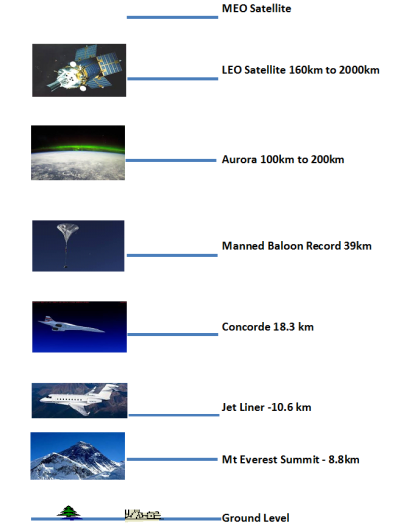On 24 October 2014 a senior Google vice president 57 year old Alan Eustace (shown below) broke the world altitude record by jumping from a balloon from an altitude of 135,890 feet (41.4 km). When he was interviewed, after he had safely landed, he said:
“..It was beautiful. You could see the darkness of space… “
This made me think about what do we actually mean by ‘going into space’? Where does the Earth’s atmosphere end and space begin? This is the purpose of this post – to try and answer this question. Those with good memory for my previous posts may also notice that some of the material in this article appeared in a longer post I published on 24 July about space tourism 🙂
What do we mean by ‘going into space’ ?
This is a question to which there is no hard and fast answer. As we get higher up, the atmosphere gets gradually thinner and thinner and very gradually merges into interplanetary space, but there is no clear line where the Earth’s atmosphere ends and space begins. Most people would agree that:
- a jet airliner flying at 35,000 feet in altitude (10.6 km) is not in space, even though a human would be dead at that altitude without supplemental oxygen, and
- the International Space Station (ISS) which orbits around 400 km above the Earth’s surface is in space.
The diagram below shows a number of key altitudes above the surface of the Earth.
Various Key Altitudes
- The summit of Mount Everest -8.8 km. At this point the air pressure is only one third of that at sea level and even a fit young person acclimatised to altitude could not survive for more than 30 minutes without extra oxygen.
- A jet airliner -10.6 km. This is the height at which a jet airliner flies on a long journey. The air pressure at this height is around 27% of that at sea level and a human would be dead within minutes from lack of oxygen.
- Concorde -18.3 km. This is maximum altitude at which the supersonic aeroplane Concorde could travel. Indeed Concorde, which is sadly is no longer in service, could travel at twice the speed of sound and was advertised as travelling ‘on the edge of space’. At this altitude the air pressure is around 6% that of sea level and the air is so thin the the sky is dark blue in daytime. At this pressure the boiling point of water is around body temperature so that any exposed liquids in the eyes, mouth throat and the lining of the lungs will literally boil away. An extremely unpleasant fate to happen to anyone! To prevent this happening, a human would need to be enclosed in a pressurised space suit to survive.
- The 2012 manned balloon flight record -39 km. This was the previous balloon altitude record set by the Austrian skydiver Felix Baumgartner in August 2012. When the balloon reached this altitude, he jumped out wearing a space suit. On his descent he reached a speed faster than the speed of sound in free fall before his parachutes opened to slow him down – hence his nickname Fearless Felix.
Fearless Felix
Fearless Felix’s sky dive was sponsored by the drinks company Red Bull, was broadcast live on the internet and was the subject of a TV documentary. Afterwards he became a celebrity. By contrast Alan Eustace’s skydive was planned in secrecy and only a small team of people knew it was due to happen.
- Aurora 100 km to 200 km. Aurora are caused by high speed electrically charged particles from the Sun hitting the Earth’s upper atmosphere, at altitudes of 100 km upwards, causing it to glow. Incidentally, Mrs Geek and I hoped for a sight of the Aurora Borealis, more commonly known as the Northern Lights, when we visited Helsinki, Finland in September.as they are rarely visible in England. Unfortunately we didn’t get to see them
- Low Earth orbit -160 km to 2000 km. 160 km is the lowest altitude at which a satellite can remain in orbit. At this altitude, a satellite would be slowed by air resistance, caused by traces of the Earth’s atmosphere, which means it would lose energy and spiral down to Earth within a day. As we get higher than this the atmosphere continues to get thinner and thinner and satellites are slowed less and less by air resistance, enabling them to stay in orbit longer. The International Space Station, which orbits at an altitude of 400 km, loses altitude at the rate of around 2 km per month and rocket motors attached to the station or on visiting spacecraft need to be used a few times a year to lift it higher up, thus maintaining its orbit and preventing it from crashing down to Earth.
- Medium Earth orbit -above 2000 km. Above 2000 km the traces of the Earth’s atmosphere are negligible and a satellite will remain in orbit indefinitely.
So where exactly does space begin?
The Fédération Aéronautique Internationale (FAI), the international body setting standards and keeping records in the field of aeronautics and astronautics defines space as starting 100 km above the surface of the Earth. As you can see, this is a very conveniently rounded number, which strongly suggests that it is somewhat arbitrary; but this definition that space tourism companies use. At this altitude the air pressure is around 0.00003% of that at sea level, which is too low for a conventional aeroplane to fly. Although this pressure is very low, it is still high enough to cause so much air resistance that a satellite could not possible remain in orbit. The thin air would cause it to burn up like a meteorite.
Next Post
In my next post I will continue my series about the Universe and talk about its history from the Big Bang until the current time.




[…] although it is classified as being in space, which begins at an altitude of 100 km, (see my previous post), here are sufficient traces of the Earth’s atmosphere to cause the ISS to lose energy as it […]
LikeLike
[…] this altitude, though it’s categorised as area (which begins at an altitude of 100 km, see my previous post ), there are ample traces of the Earth’s environment to trigger the ISS to lose power because it […]
LikeLike
[…] At this altitude, although it is classified as space (which begins at an altitude of 100 km, see my previous post ), there are sufficient traces of the Earth’s atmosphere to cause the ISS to lose energy as it […]
LikeLike
[…] altitude, though it’s categorised as house (which begins at an altitude of 100 km, see my previous post ), there are enough traces of the Earth’s environment to trigger the ISS to lose power because it […]
LikeLike
[…] At this altitude, although it is classified as space (which begins at an altitude of 100 km, see my previous post ), there are sufficient traces of the Earth’s atmosphere to cause the ISS to lose energy as it […]
LikeLike
Really enjoyed reading your blog and look forward to your next post.
LikeLike
Reblogged this on SandraBranum's Blog and commented:
“Fascinating” as Spock would say raising one eyebrow.
LikeLike